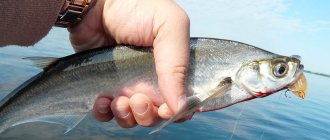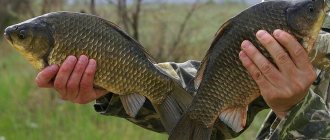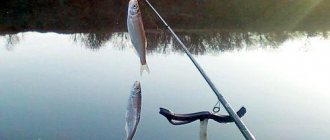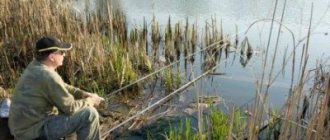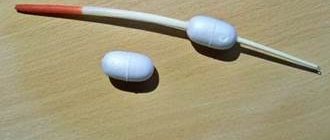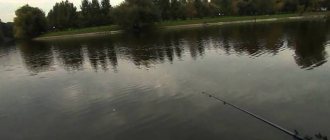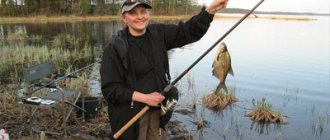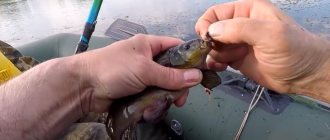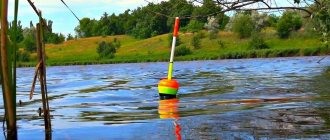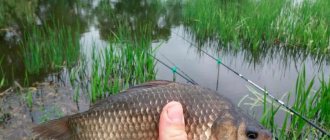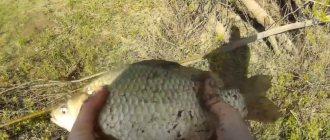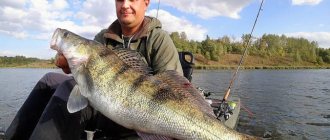Pike perch belongs to the perch family and, like perch, is a predator leading a bottom-dwelling lifestyle. This fish can be found in almost all large rivers or lakes where there is clean water and appropriate conditions for its habitat. Prefers to be at depth and closer to the bottom. At the same time, it should not be smooth, with differences in depth, but not muddy, but rather sandy or rocky. It also does not feel bad in places where trees or bushes are drowned or there are a lot of snags. To catch this predator, you need to become familiar with its behavior and diet, as well as the characteristics of gear for fishing for pike perch. Basically, pike perch is a schooling fish, but larger individuals can hunt alone. In muddy bodies of water, where there is little oxygen and no clean water, pike perch can hardly be found.
Advantages and disadvantages of the method
The use of live bait allows you to catch pike perch not only during periods of high predator activity, but even when the use of various artificial baits does not produce any results.
The main advantages of this fishing method are:
- Active and naturalistic movement in the water column of a fry mounted on a double or tee. No artificial bait can fully imitate the movements of a live fish.
- Cheapness and simplicity of the equipment used. For live bait fishing, you can use inexpensive rods, reels, simple but strong monofilament line or braided cord.
- Possibility of simultaneous use of several gears. Since live bait fishing is stationary, this allows you to use 2 or more gear at the same time. At the same time, a very large area of water is fished and the chance of catching fish increases.
- Stationarity and relatively low labor intensity. Live bait fishing, unlike fishing for pike perch with a spinning rod, does not involve frequent casting and retrieving. This makes this type of fishing less tiring and time-consuming, which many people like, especially older fishermen.
- High catchability. Using live bait allows you to catch pike perch not only during periods of high predator activity. There are situations when the use of various silicone baits or pike-perch wobblers does not produce results.
Disadvantages of fishing with live bait:
- Using sufficiently voluminous fishing equipment - a small fish, eland or other vessel for storing live bait;
- High cost of live bait in fishing stores;
- A long process of independent production of fry;
- During the fishing process, it is necessary to monitor the condition of the live bait - often change the water, throw out dead fish that have floated up with their bellies, place the kana with bait in a shady place not illuminated by the sun.
Live bait fishing, unlike spinning, allows you to catch larger trophy pike perch. The weight of caught specimens reaches 5 kilograms or more, while artificial baits usually catch 2-3 kilogram pike perch.
Choosing a place and time of fishing
In the evening, early morning, and also during the night, pike perch often goes to the sandbanks adjacent to the deep parking areas.
The most promising places for live bait fishing are:
- Snagged and littered river holes and whirlpools;
- The lower edges of the slopes of channel pits within the reaches;
- Coastal ditches under steep banks;
- Deep areas with a hard sandy, clayey, pebble or shell bottom.
Recommended reading: Tackle for carp with makukha
Small pike-perch along with small perch are often found on sandy shallows that are partially overgrown with grass.
Fanged fish are caught in this way throughout the open water season. The most active bite for live bait is in the summer, at the end of May - beginning of June and in the fall, until mid-October. With a sharp drop in water temperature, pike perch slide into deep wintering holes, where they spend most of the winter.
On a note! To catch pike perch, choose areas with medium currents, deep places on the border of the main and reverse streams.
Basic fishing gear
In live bait fishing, such gear as a donka, a float rod, a girder, and mugs are used.
Donka
To notify the fisherman about a bite in such gear, ordinary bells or electronic alarms are used.
Bottom tackle for fishing with live bait consists of:
- A rigid spinning rod 2.4-3.0 meters long or a “river” 360-390 centimeter feeder;
- Spinning reels size 3000;
- Main monofilament line with a cross section of 0.35 mm;
- Fasteners (carbine) with a swivel tied at the end of the main fishing line;
- 80-110 gram flat sinker with protrusions with lugs fastened to a carabiner at the end of the main fishing line;
- A leash made of monofilament with a cross section of 0.27-0.3 mm and a length of 70-100 cm is tied 20-25 cm above the sinker. The leash is equipped with a single hook No. 2/0-1/0.
To notify the fisherman about a bite in such gear, ordinary bells or electronic alarms are used.
Float rod
The equipment of a fishing rod for pike perch includes a sliding sinker-olive weighing from 8 to 10-12 grams, a large float that moves freely along the fishing line, and a meter-long leash with a single hook No. 2/0.
Live bait float tackle consists of a rigid match or Bolognese rod with a length of 3 to 4-4.5 meters, a spinning reel of size 2000-2500 with a 40-50 meter supply of monofilament with a thickness of 0.25-0.3.0 mm. When fishing with such gear, the sinker is allowed to sink to the bottom after casting. Install the float so that it lies completely on the water surface. Such loading of the alarm is done in order to reduce the influence of waves or wind on it, making the bite noticeable even from a distance of 15-20 meters.
Zherlitsa
It is a wooden slingshot on which 10-15 meters of main fishing line with a cross-section of 0.3 mm are wound with a sliding sinker weighing up to 10 grams, a line leash up to 80-100 cm long.
This gear is used when fishing for pike perch in snag holes located near the shore and whirlpools, under steep yars.
We recommend reading: The most catchy wobblers for asp
For river fishing, a triple swivel rig is used, to two perpendicular rings of which a leash and a piece of fishing line with a flat sinker weighing up to 40-60 grams are tied.
Gear used for fishing
Tackle for pike perch for live bait fishing is selected taking into account fishing conditions, characteristics of the reservoir, time of year, possible sizes of expected prey, and also guided by the personal preferences of the fisherman. Using this method, this predator is caught all year round, even in winter, from the ice. But what gives an angler special joy is catching pike perch in the spring, using live bait or any other bait. During this period, this predator noticeably becomes more active after winter stagnation.
Expert opinion
Knipovich Nikolai Mikhailovich
Zoologist, hydrobiologist. I am interested in fishing at a professional level.
Attention! After the first fish you catch, stay in this place further. Pike perch, as a rule, does not walk alone; somewhere nearby there are other members of its flock, which can also get caught on your hook.
Select tackle for catching pike perch with live bait in the spring, when the ice has completely melted and nature has come to life, depending on the place where you will be fishing. If this is a large body of water, a large lake or reservoir, and a predator is walking there at a distance from the shore, then it is rational to think about hunting it from a boat. Hunting for pike perch from a boat with live bait on a large body of water, especially if the angler knows the places where it lives, can be crowned with a rich catch, and, most likely, you will not come across small fish in such places.
To catch a predator using live bait, the following methods are most often used:
- On a float rod. In this way, small pike perch are usually caught at the edge of the shore or from a boat at shallow depths. The Bolognese fishing rod is best suited for this. It will be easy for her to control the tackle and catch prey.
- With bottom tackle in all its variations : imported tackle with a rubber shock absorber, a regular donka, a feeder, etc. This is how it is usually caught in the summer and autumn, when it goes to the depths.
- Zherlitsy. This simple tackle, which in most cases looks like a slingshot with a fishing line wound around it, works well when catching pike perch with live bait in the current. It could be a small river or erik.
- Mugs. This is a close relative of girders, but they can only be used in bodies of water without a current.
In addition, some anglers like to catch this predator in a vertical line, using picker rods or strong winter fishing rods.
Expert opinion
Knipovich Nikolai Mikhailovich
Zoologist, hydrobiologist. I am interested in fishing at a professional level.
Attention! When fishing with girders, it is very convenient to use a boat to install and remove them. With its help, girders can be installed in the most secluded places, inaccessible from the shore.
Perhaps the most popular is fishing for pike perch using live bait on a feeder , although many fishermen associate this method only with catching white, peaceful fish. With the help of this gear, it is caught most of the year, on almost any body of water, when pike perch is caught with live bait from the shore and a good cast is needed. This is where the feeder rod will show its best qualities.
Feeder equipment for catching pike perch with live bait is not much different from the classic version. Also, as the main load, you can use a feeder with bait for white fish; it will additionally attract other fry, only the leash should be stronger and live bait should be attached to the hook, and not a worm. This method is equally effective for catching predators with live bait both in the current and in almost stagnant water, in backwaters.
About bait
The most suitable bait for such fishing is a small live fish. It is desirable that the proposed live bait be familiar to the pike perch and look as natural as possible.
What live baits are suitable for catching pike perch?
To catch pike perch, use such live bait with a narrow, slender body as:
- Bleak;
- Verkhovodka;
- Minnow;
- Tulka;
- Gudgeon;
- Carpenter;
- Okushok;
- Little ruff.
More tenacious crucian carp, rudd and bream are not used, since they have a rather wide body and rarely become prey for pike perch.
The optimal length of live bait used is from 7-8 to 10 cm.
Where to get live bait
The fry are usually caught in the same body of water in which they plan to fish in the future. It is mined in two main ways:
- a light float fishing rod with thin equipment - a line no more than 0.12 mm thick, a light float with a weight of 0.5 grams, a thin leash with hook No. 18-20;
- whelp with a mesh mesh size of no more than 10 mm.
An alternative device for catching live bait can be a plastic bottle with holes made with an awl, in which the cut neck is inserted so that its wide part faces outward.
The simplest muzzle from a plastic bottle.
To catch live bait, a little bait or white bread crumb is poured inside such a device and, tied with a rope to a long stick, it is lowered horizontally to the bottom of the shallows. Live bait, attracted by bait or bread crumbs, willingly swims through the funnel neck inside the bottle, but cannot swim out.
Live bait bait methods
There are several ways to place live bait on a hook:
- Behind the back - with a hook they pierce the back of the fry, while trying not to damage its spine;
- Through the gills - the fishing line segment of the leash is passed through the gills of the fry and taken out of its mouth. After that, a double hook is tied, which is fixed in the mouth of the baitfish by pulling the leash in the opposite direction.
We recommend reading: What is bombarda and how to catch sbirulino with a float
In some cases, the fry is simply caught by the lip. Pierce the upper or lower lip of the fish, bringing the sting of the hook out.
Features of choosing live bait for catching pike perch
Content
There are generally accepted rules for the correct selection of live bait for predatory fish, and the main one is to choose small fish that are the usual prey for pike perch in a specifically selected body of water. If there is an opportunity to fish for a predator in a large body of water - a river, as well as a reservoir, then the selection of live bait is very diverse. After all, even a not very hungry pike perch cannot resist its favorite “delicious food”, succumbing to the hunter’s instinct.
Small, narrow-bodied fish are the best choice for live bait.
The best choice as live bait for a fanged predator would be small, narrow-bodied fish:
- bleak;
- top melter;
- gudgeon;
- roach;
- goby.
Small invertebrates are excellent baits, but they are more difficult to obtain because they require special equipment, while small fish are quite easy to catch. Malek asp and ide are not suitable as live bait.
After choosing the bait, you should learn how to bait the bait so that, as far as possible, it remains mobile on the hook longer, attracting the attention of predators. You can place live bait on the hook by the lip and under the dorsal fin, and when fishing in the current, by the nostril. Pre-prepared live bait must be stored in a special container or in a cage made of fine mesh.
Equipment for catching pike perch with live bait directly depends on the size of the expected catch, but the basic principles for selecting components are as follows:
- choose a reliable fishing rod;
- preference should be given to a spinning reel;
- you need a strong fishing line that can withstand the resistance of a heavy predator;
- The hooks must be very sharp, capable of easily piercing the hard mouth of a pike perch.
Read more
How and what to catch burbot?
Night fishing with live bait
At night, pike perch are caught using live bait both from the shore and from a boat. For boat fishing, they use mugs with fireflies placed on the masts for better visibility and small pieces of reflective material wrapped around them. For fishing from the shore, spinning rods up to 3 meters long are used.
You can catch pike perch at night using live bait in places with holes, dumps, and irrigation areas bordering the depths.
When fishing for pike perch with live bait, you should remember that you cannot take fish the size of the fishing standard established by law (40 cm). By catching fish less than this limit, the fisherman causes enormous harm to the pike perch population and risks being seriously punished by environmental authorities.
Catching pike perch on a predatory feeder
The feeder for feeder gear can be filled with either bait for non-predatory fish or a mixture of breadcrumbs mixed with pieces of fish. In the first case, this will attract the fry to the bait, which is also important, and in the second, it will attract the predator itself. Any fish is suitable for bait, even sprat or capelin from the store. After casting, the feeder rod is positioned at an obtuse angle to the shore. This will allow you to lift the bait from the bottom. The time between casts should not exceed 20-25 minutes.
But it’s much faster to get several fry at once with a “baby catcher” - a small lift made of mesh. They are lowered into the water in the shallows. They are fed with cereals and crumbs and after 15 minutes they are lifted ashore. Individuals of suitable size are removed.
